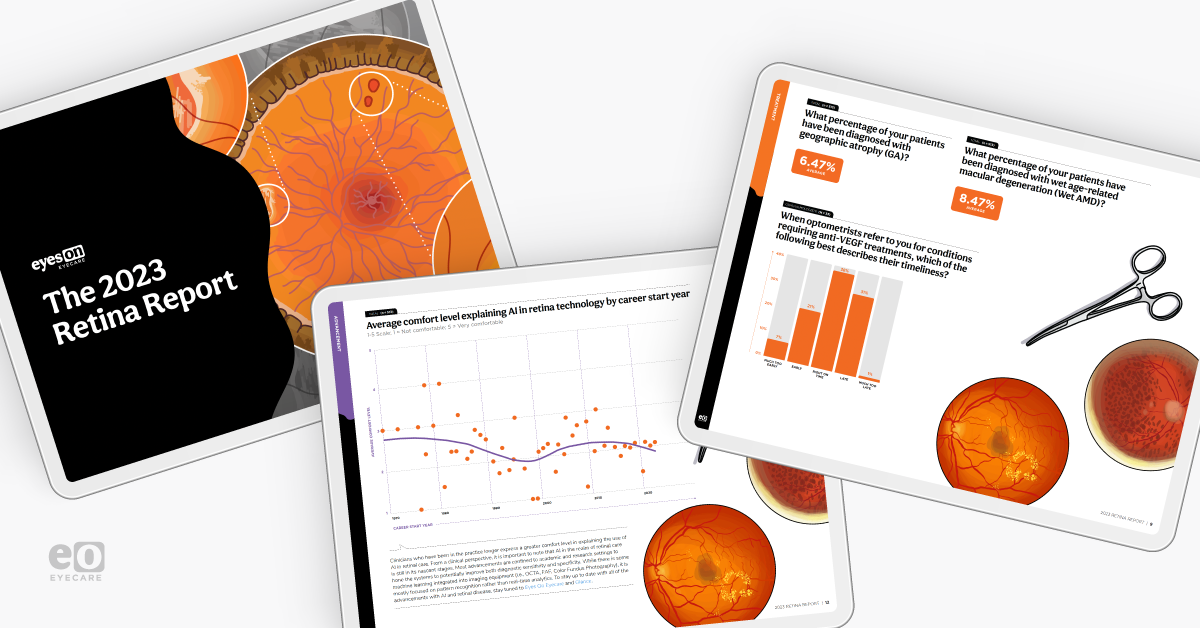Retinal disease is one of the leading causes of vision impairment and blindness worldwide, with age-related macular degeneration accounting for an estimated 8 million cases around the globe.1 Diabetic retinopathy accounts for another 3.9 million cases and is reported to be a leading cause of vision impairment in middle-income countries, according to the World Health Organization (WHO).2
We ran this survey in August 2023 to better understand the main challenges facing eyecare practitioners (ECPs) today regarding the diagnosis, treatment, and management of various retinal diseases. We wanted to learn what roadblocks were presented by patients and practice workflows as well as look at the effects of the rapid advancements in the retina space. Additionally, we wanted to gauge the general awareness among practitioners of these latest advancements.
Download the free version of the 2023 Retina Report, or keep reading for a sneak peek at the findings!
Get the free Retina Report
Uncover the core challenges encountered by eyecare practitioners in diagnosing, treating, and managing retinal diseases, as well as the obstacles posed by patient interactions, practice protocols, and more!
The 2023 Retina Report covers:
- Confidence in diagnosis and treatment of retinal diseases
- Common equipment brands
- Innovation and the retina pipeline
- And more!
Who’s who in the Retina Report
In response to our 2023 Retina Survey, we initially received a total of 724 responses—659 from optometrists and 65 from ophthalmologists. After a rigorous process of data cleaning and confirming the credibility of the respondents, we validated 513 responses for analysis.
This refined sample included 480 optometrists and 33 ophthalmologists, 99% of whom actively treated retinal disease. The data cleaning process helped us eliminate any outliers or questionable entries, ensuring that the insights and statistics you'll find in this report are both accurate and meaningful.
What retinal diagnostics do doctors have access to?
Among our respondents,
16% reported that their practice lacked
ocular coherence tomography (OCT). Another
55% did not have
OCT-angiography, a significant technological advancement in diagnostic imaging to identify certain nuances of retinal disease, such as AMD, macular holes, and choroidopathy, to name a few.
How confident are ECPs in diagnosing geographic atrophy?
When it comes to
geographic atrophy (GA)—a growing concern among the ophthalmic community—respondents reported
high confidence in both diagnosing and treating the condition, but nearly
75% described their knowledge of treatment options as
“Intermediate” or lower.
There are a plethora of treatments for GA in the pipeline, as well as the commercially available SYFOVRE (pegcetacoplan injection) 15 mg/ 0.1 mL and IZERVAY (avacincaptad pegol intravitreal solution) 2 mg, two treatments that were approved by the FDA just this year.
That said, only 2% of respondents reported a high awareness of the retina treatment pipeline; 85% were “somewhat aware” or less.
How quickly are optometrists referring patients?
When asked about
referral timelines for conditions requiring anti-VEGF treatment, ophthalmologists said that
32% were
late or
much too late.
This marks an area for further exploration into what factors contribute to this number and how optometrists and ophthalmologists could better collaborate to catch these patients earlier in the disease process.
Learn more about the state of retinal disease diagnosis and treatment by downloading the full report!


